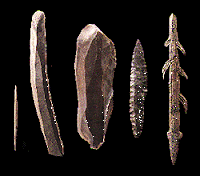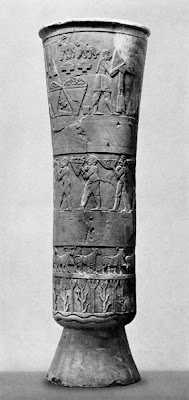The Beginnings of Art
(various sites in France)
source: http://www.handprint.com/LS/ANC/stones.html
source: http://www.handprint.com/LS/ANC/stones.html
The capacity to enjoy aspects of experience that relate to the relatively autonomous play of perceptual abilities and motor activities resulting in a sort of realization and confirmation of our “sensuous self” (however mediated), that is, our corporeal being and vital impulses, is an important part of what we may call “aesthetic satisfaction”.
Leroi-Gourhan (*) lists three main domains of the “expression of aesthetic feeling” or “aesthetic satisfaction” related to the early stages of humanity that may contribute to our understanding of the beginnings of art:
1) Psycho-physiological impressions: having its own “pre-history” in the animal world, are related to “the issue of predatory and sexual incentives”, exemplified, for instance, in bodily ornamentation such as the canines of animals used as pendants. The impressions and emotions related here are “not directly aesthetic”, but constitute one of the elementary sources and, according to Leroi-Gourhan, an initial mode of manifestation of the experience of “beauty”.
2) Magic-religious: the use of animal canines as ornamentation refers as well to the appropriation of the animal’s perceived potency and manifested powers.
In this regard we can also observe that, if mimesis is adaptive behavior (with a biological basis, according to the function of mimicry in the natural world), the perception of an animated world of nature will lead man to devise ways of getting closer to, modeling and transforming himself, identifying himself to those other beings and forms of life with their unique powers. Mimetic behavior is at the source of artistic developments.
3) Techno-economic: in the creation of stone implements, according to Leroi-Gourhan, the “animal aesthetics” of the preceding domains is supplemented by “functional aesthetics”. The creator of implements is here, as his skills and knowledge develop, the creator of forms more and more regular and more and more adapted to their functions. The development of form results in economy of materials and gestures, the precision of work creating precise instruments, the creation of forms expressing total mastery and attaining a “purity” of design that characterizes, for Leroi-Gourhan, the mark of the “beautiful”. We have at this point, for the anthropologist, the sign of a conscious appreciation of formal qualities, that is, of the “aesthetic” as such.
“Conscious art” (the term is by Leroi-Gourhan) evolves from what we may call an “unconscious artistic element”, or rather, elements that are part of activities guided by different aims but that involve, all of them, a realization of a sort of “final”, that is, complete form or stage related to vital demands, abilities and impulses.
A complete form integrates material and activities within itself in such a way that parallels the classic notion of the identity between form and content in the realized work of art. In Hegel’s version: the becoming form of content, and the becoming content of form. That is, a complete form is without residues of materials and of human energies: all is spent and yet nothing is lost. The artwork is work conscious of it’s own self-realization.
Art is certainly not a separate domain of activity for early man. But perhaps we may conclude that what we call nowadays artistic behavior and capacities, integrating perceptual, imaginative and intellectual abilities, formed one of the central structuring factors of early human activity, contributing to success in adaptation, survival and development.
Marcelo G. Lima
(*) Leroi-Gourhan, A. The Beginnings of Art in Larousse Encyclopedia of Prehistoric and Ancient Art, London: 1967



Comments